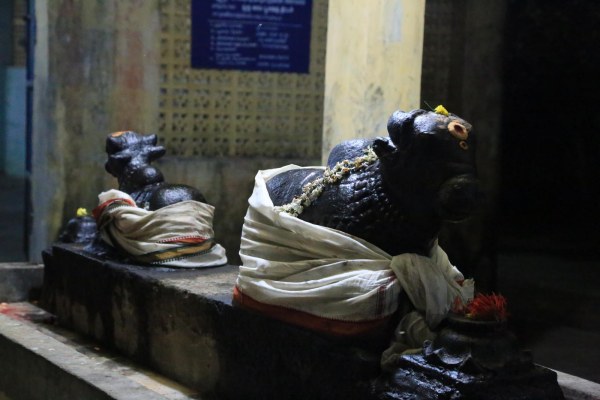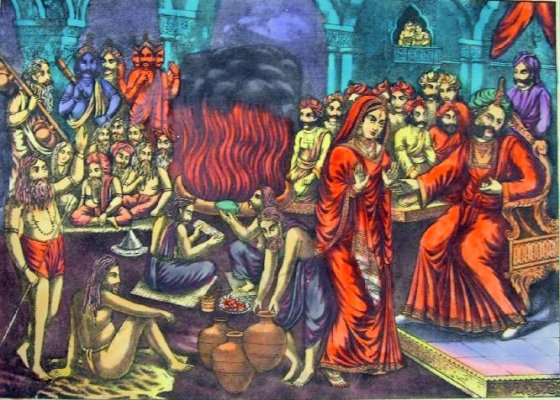Tirunangur, or Nangur, located about 11 km south-east of Sirkazhi and about 23 km north-east of Mayiladuthurai, is probably best known for its Divya Desam temples – there are a total of 11 in and around Tirunangur. Together, they are popularly referred to as the Ekadasa (eleven) Divya Desams.
However, as with many legends, the legend of Nangur is also heavily connected with Siva (in this case, the Rudra aspect of Siva), and dates back to Daksha Samharam by Lord Siva. This point may recall to our readers, the concept of Ekadasa (eleven) Rudras. But more about that shortly.
Origin of the name Nangur
In Sanskrit, Naga also means elephant. Indra’s elephant Airavata worshipped at the Badrinarayana temple (Tiru Manimaada Koil), and so this place was originally called Nagapuri, which later got corrupted to Nangur.
Ekadasa Rudras
Rudra or Rudras are identified with, and as an aspect of, Siva. According to the Ramayana, they are eleven sons of Sage Kashyapa and Aditi (along with 12 Adityas – dwadasa-aditya, 8 Vasus – ashta-vasu, and the 2 Ashwin twins). The Mahabharata also references the 11 Rudras. The Vamana Puranam also considers Rudras as the sons of Sage Kashyapa and Aditi, while the Matsya Puranam considers the Rudras as the offspring of Surabhi, a consort of Brahma.

According to the Vishnu Puranam, Rudra was born in Ardhanari form, from the anger of Brahma, and thereafter split into 11 Rudras (from the male aspect of Ardhanari) and 11 Rudranis (from the female aspect of Ardhanari).
Similarly, there are various other texts that reference the Rudras. In all of these texts as well as the above-specified epics and texts, the names of the Rudras are often different. However, one consistent understanding is that Rudra is considered one of the fierce aspects of Lord Siva (similar to Bhairavar).
The legends of Nangur temples
After the events of Daksha Yagam, Siva was inconsolable. As Rudra, he started a terrible and fierce dance – the Rudra Tandavam – and every time his flowing hair touched the ground, another Rudra sprang up – this way, there came to be a total of eleven Rudras. All of this took place at what is Nangur today, at a place called the Ubaya Kaveri, lying between the Maniyaru river in the north and the Kaveri in the south. To avoid further damage to the world, and to pacify Lord Siva, Lord Vishnu appeared as Paramapada Nathar.

Siva then requested Vishnu to be present in as many forms as there were Rudras (11). Each of those forms are said to be the at the eleven Tirunangur Divya Desam temples (Ekadasa Divya Desams, or eleven Divya Desams). Each such temple has a corresponding Rudra temple, which are referred to as the Ekadasa Rudra Peethams. Two of the Rudra Peethams are not yet consecrated as structural temples, but their worship idols are housed in another temple.
Update – August 2022 – I heard another small variation of the above story, and found that one interesting. Vishnu also attended Daksha’s yagam at the latter’s invitation. When Siva brought Veerabhadrar to life in order to fight at the yagam, Vishnu was bound to protect Daksha who had invited him. But after giving fight for some time, Vishnu acknowledged defeat, because he knew he was fighting an unjust cause (Dakhsa’s ego resulting in him not inviting Siva to the yagam).
According to another legend, Lord Siva performed the Ashwamedha Yagam in 11 places, to rid Himself of Brahmahathi dosham, after He plucked one of the heads of Brahma. Lord Vishnu blessed Lord Siva and the Rudras at each of these 11 places.
In a lighter vein, Saivites often state that Lord Vishnu came to the 11 Nangur Rudra Peethams to worship Lord Siva, while Vaishnavies state that it was Lord Siva who came to the 11 Divya Desams to worship Lord Vishnu. But as a result of this, we as pilgrims have benefited, as we get to visit and worship at these 22 temples, and more, in this region.
The Nangur Divya Desams and Rudra Peethams
Each temple listed below (and in particular, the Divya Desam temples) has its own sthala puranam, which is often independent of the above legend of Nangur. Also, each Perumal is believed to have come from another important Vaishnava Sthalam – such as Badrinath, Srirangam, Kanchipuram, Ayodhya, Dwaraka, Brindavanam, etc.
| Divya Desam temple (Deity, Location, District) | Rudra Peetham temple (Deity, Location, District) | Peetham |
| Gopalakrishnan, Tirunangur, Nagapattinam | Sundareswarar, Annappanpettai, Nagapattinam | Rudra Peetham |
| Kudamadu Koothan, Tirunangur, Nagapattinam | Jurahareswarar, Tirunangur, Nagapattinam / Amritapureeswarar, Tirunangur, Nagapattinam | Soma Peetham |
| Purushottama Perumal, Tirunangur, Nagapattinam | Nambuvarkanabar, Tirunangur, Mayiladuthurai | Mahadeva Peetham |
| Perarulalan, Tirunangur, Nagapattinam | Swarnapureeswarar, KaTiruppu, Mayiladuthurai | Sadyojata Peetham |
| Badrinarayanar, Tirunangur, Nagapattinam | Mathangeswarar, Mathangashramam, Naapattinam | Tatpurusha Peetham |
| Vaikuntanathar, Tirunangur, Nagapattinam | Kailasanathar* | Bheema Peetham |
| Devanayaka Perumal, Tirunangur, Nagapattinam | Airavateswarar, Perunthottam, Mayiladuthurai | Ugra Pirana Peetham |
| Varadaraja Perumal, Tirunangur, Nagapattinam | Sundareswarar* | Bhava Peetham |
| Srinivasa Perumal, Tirunangur, Nagapattinam | Yogeswarar, Mangaimadam, Mayiladuthurai | Vamadeva Peetham |
| Pallikonda Ranganathar, Tirunangur, Nagapattinam | Naganathar, Allivalagam, Mayiladuthurai | Sarva Peetham |
| Parthasarathy Perumal, Tirunangur, Nagapattinam | Nayanavaratheswarar, Sembanthaniruppu, Mayiladuthurai | Aghora Peetham |
In the Tamil month of Thai (January-February), the Garuda Sevai utsavam takes place at the nearby Badrinarayana Perumal temple at Nangur, where the Perumal and Garuda of each of the 11 Nangur Divya Desam temples arrive here. This festival is a must visit for those who are interested.
Read about each of the temples by clicking the links on the respective temple names (many of these are yet to be updated as of now).
